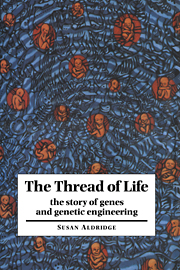5 - Genetic engineering
from PART II - Engineering genes
Published online by Cambridge University Press: 16 March 2010
Summary
Knowing the structure of DNA – and how it works – has created many exciting new possibilities in the world of biotechnology (the use of biological processes to make useful products). Probably the most important technology to flow from Crick and Watson's discovery is genetic engineering.
The tools of genetic engineering allow the transfer of genes from one species to another. Because different species cannot usually breed with one another and exchange genetic material, genetic engineering opens up the prospect of creating novel species. These have the potential to widen the scope of biotechnology in ways that will have a major impact on medicine, agriculture and the environment.
For instance, the first commercial example of genetic engineering involved the transfer of the gene for human insulin to the bacterium E. coli. While humans and bacteria share a common ancestor, they can breed together only on the wilder shores of science fiction. With genetic engineering, a bacterium can acquire a human gene – and treat it as one of its own. In some ways there is nothing very new about this; every time you get a cold you acquire unwelcome viral genes, but the point about genetic engineering is having some control over the transfer process. Genetic engineering always creates an organism with a novel genome, although it usually only differs by one gene from its genetically unmodified counterpart. So an E. coli bacterium with a human insulin gene does not look remotely human, or in any other way unusual!
Sometimes the creation of a novel organism is incidental and it is the product that the organism makes which is the target of the process.
- Type
- Chapter
- Information
- The Thread of LifeThe Story of Genes and Genetic Engineering, pp. 103 - 112Publisher: Cambridge University PressPrint publication year: 1996



